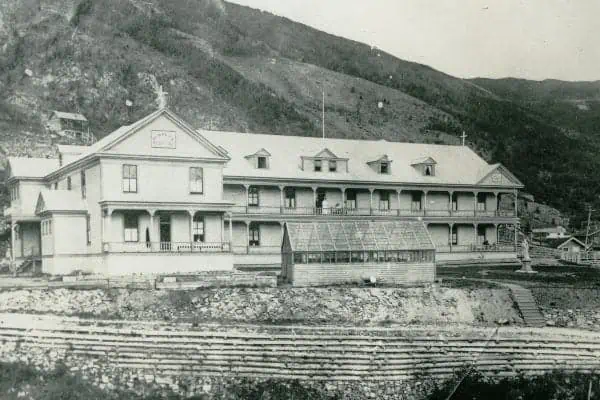There was a not-so-urban myth out there that you could see the Tintina Trench from the moon. That is not true, unless the person on the moon had a good telescope. You can see the Tintina Trench from space, though, from the International Space Station. Most of the rest of us will have to use Google Earth, which shows it just as well too.
The Tintina Trench is a geological feature that cuts the territory in a slightly kinked, almost straight line. From Watson Lake in the southeast it runs to just south of Ross River, through Faro, on to Stewart Crossing, then just north of Dawson. Downstream, northwest of Dawson, the trench picks up the Yukon River as it flows past Forty Mile, across the border to Eagle and just past Circle, Alaska.
The easiest way to see it is on the Yukon Geological Survey terrane map. Terranes are groups of different rocks that are related. On the map you can see the big difference in colours representing different terranes on either side of the Tintina Trench.
The Tintina Trench is actually a series of parallel faults in the rock in a zone anywhere from one to 15 kilometres wide and 1,000 kilometres long. The fault is what is known as a strike-slip fault. The ground doesn’t move up or down, the two sides along either side of the fault slide or slip horizontally in different directions.
Pretend you are standing still on one side of the fault, facing your friend on the other side of the fault. If your friend appears to be moving to your right, the fault it is called right lateral. If your friend moves to your left it is left lateral.
If you and your friend hung out on the Tintina fault for the duration, not only would you be really old, but your friend would be about 430 kilometres to your right. Dawson City and Ross River were actually those “friends,” a long time ago. Dawson and Ross River were only a few kilometres apart, but on different sides of the fault.
Modern geophysical tools allow geoscientists to see deep within the Earth’s crust. Surveys across the Tintina Trench have sent seismic waves many kilometres down into the crust to record the reflections that come back. Much the same way that oil and gas companies explore today, but much deeper. The survey indicated a steep-sided break in the rocks, all the way through the crust, down to a depth of 30-plus kilometres.
Today, the Tintina system is relatively quiet—both movement and earthquake wise—compared to the southwest Yukon. The drive between Ross River and Dawson should not be getting stretched longer in the near future.
The Tintina Trench is related to the Rocky Mountain Trench in British Columbia. Running south of the Yukon border, the Rocky Mountain Trench continues south through Mackenzie, Valemount, Golden, past Cranbrook and into Montana.
The first written reference of the name “Tintina Trench” was by Joseph Keele in a 1904 Geological Survey of Canada Annual Report. The word is referenced to be from the Tahltan language.
This linear break through many mountain ranges served as a natural transportation route to the First Peoples here. The lowlands were generally full of rivers or lakes. Good for both transportation and wildlife. The trench system is also a natural corridor on the Pacific Flyway for swans, cranes and other migratory birds. Before GPS, pilots relied on the long, straight valleys of both the Rocky Mountain and Tintina Trench systems for navigation in poorer weather.
The fault system was thought to have started moving about 170-million years ago, with the majority of movement occurring 70- to 110-million years ago. The exact rate of movement is not known and it probably varied.
The best modern-day analogy to the Tintina system is the very active San Andreas Fault in southern California. It, too, is a right lateral fault slowly moving the Los Angeles area up the coast towards Alaska. Its rate of movement averages two to four centimetres a year, but there can be big jumps. The huge 1906 San Francisco earthquake moved the ground eight metres all at once.
You can actually drive along the trench on our beautiful Yukon highways. The section of the Robert Campbell Highway between Faro and Ross River travels right along the trench. The longest section for driving along the trench is the 135-kilometre section between Stewart Crossing and the Dempster Highway turnoff on the North Klondike Highway.
You will not see too many rocky outcrops on either highway. The fault systems generally form low areas, which, over the millennia, fill with sediments and glacial till. The section between Ross River and Faro is almost entirely overlain by thick glacial tills made of sand, silt and cobbles.
The area from Stewart Crossing to Dawson did not experience the last glaciation but has undergone a long period of erosion and buildup of residual soils. If you are travelling north on the Klondike Highway, a couple of kilometres past the Ethel Lake turnoff is the spot where the fault is mapped as crossing the highway. Although you will not see too much indication of it as you drive.
Actual closeup evidence of the faults themselves has been uncovered farther north. Placer miners on All Gold Creek, about 55 kilometres south of Dawson, reported areas “hundreds of feet wide” of bedrock gouged and crushed to sand. Highways work in that area has also uncovered similar occurrences.
Between Stewart Crossing and the Dempster turnoff, you will zig zag across the trench about four times. It won’t be easy to see exactly where this happens along the highway. Keep the trench in mind as you travel. See if you can spot any indications as you drive along. There are a number of good vantage points along the route to safely pull over and look at the general topography and see if you can spot any features of the Tintina Trench.
The best place to start your Klondike Highway Tintina Trench drive is at either end of the section. In the North, the Government of Yukon rest area, about 60 kilometres south of Dawson City, is dedicated to the Tintina Trench. Interpretative panels show how glaciation has changed the flow of major rivers in the trench. At the other end of this section, by the north end of the bridge, over the Stewart River, is an outcropping of rock. This is one of the few areas you will see bedrock by the highway, near the trench, and one of the most colourful for sure.
If you are on the Faro–Ross River section, the Lapie River, crossing on the South Canol Road, is worth the stop. It’s about six kilometres south from the Robert Campbell Highway intersection. Here you are very close to the southwestern edge of the trench, with good exposures of rock along the river. See if you can see any indications of the faulting.




